(Not So) Mean Joe Greene
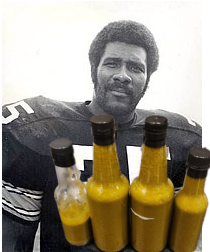
The Beginning
After moving somewhere with a "backyard," I started growing spicy peppers in pots. Last year, I only grew "mean" peppers (habanero, ghost, reaper, and scorpion). However, a number of my "friends," colleagues, and loved ones are, to put it bluntly, weak and easily defeated by a bunch of angry fruits. So, this year, I also added Hungarian wax peppers and jalapenos to the "backyard" pepper "farm" so that I could make "friendly" sauces for the feint of heart. The following is my first attempt at making a fermented "green" sauce "inspired" by the "flavors" of guacamole and margaritas. The sauce is named after famous Steeler's player Mean Joe Greene, who always said that he didn't want to be known as "mean" but rather just as "good." I have the same hopes for this not too hot sauce.
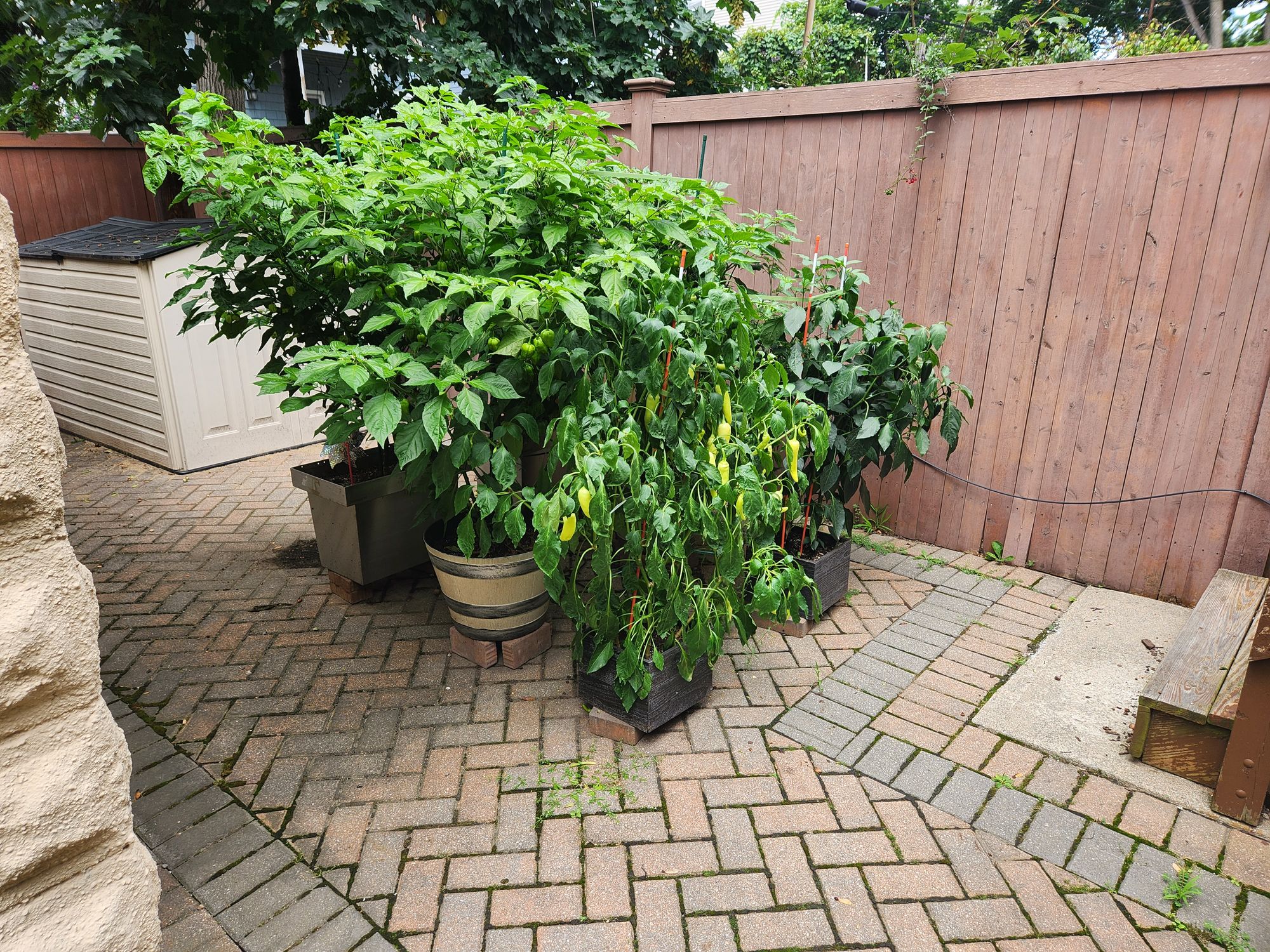
The Ferment
By processing big data from previous sauce experiments with the latest in artificial intelligence, it was determined that a decent base for a fermented sauce can be made by fermenting just the peppers (other flavors and fruits added later) in a 2.25 wt% salt brine for 1.5 to 2 weeks (until no longer producing CO2). All peppers from the farm were rinsed before use, and the stems were removed. Natural bacteria/yeast from the ambient environment are necessary for fermentation, so don't go full clorox-wipe-on-walmart-banana-during-2020 on the peppers. For the greatest odds of success, use non-chlorinated spring water and salt that is free of iodine or other additives.
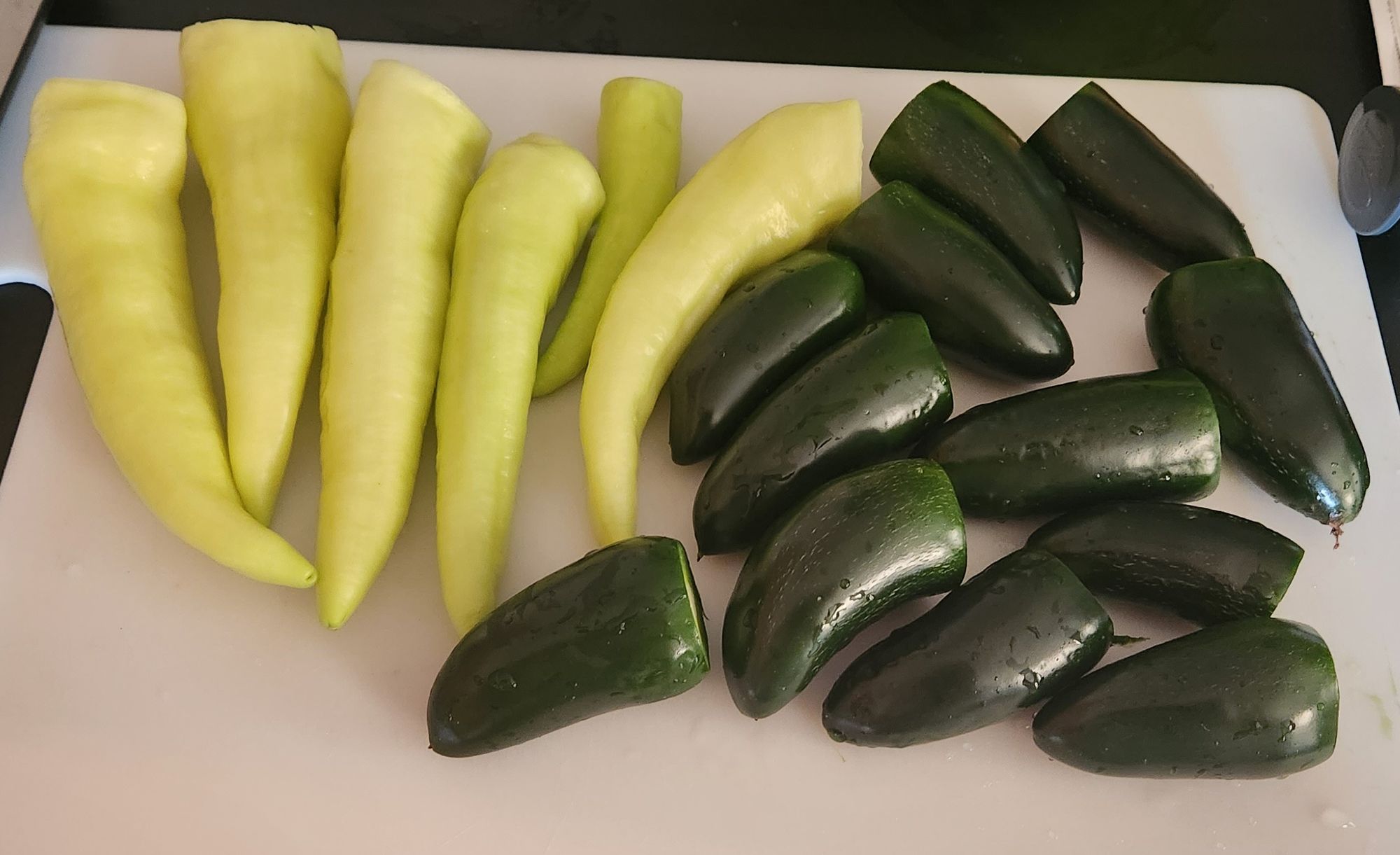
In a sterilized 1.9 L (1/2 gallon) wide-mouth jar, combine:
- 17 Jalapeno peppers - 550g - cut into octants, including seeds/pith
- 6 Hungarian wax peppers - 223g - cut into octants(ish), including seeds/pith
- Liquid Death spring water - 892g/mL

For pepper fermentation, brine concentrations typically fall in the range of 2 to 5 % by weight. Higher salt percentages tend to be used for longer ferments or ferments with a higher content of sugar. For pepper-only fermentation, I tend to stick to the low end of this range for a 1-2 week fermentation. Here, I used 2.25 wt% salt (not a true wt% as the salt in added "on top" of the pepper/water mass). The correct amount of salt is determined by multiplying the mass of the peppers and the water by 0.0225.
(550g + 230g + 891g)*0.025 ~= 38g
The calculated mass of salt was added to the jar, and the solution was gently agitated with a fork or butter knife or chopstick or whatever random rod shaped kitchen utensil was handy.
A glass weight was added to the jar to keep the peppers from floating, and the jar was sealed with a fermentation lock lid that has a 1-way valve to allow gasses to escape but not enter. The jar was kept in a cool, dark cabinet.
After a day or so, the solution should become cloudy, and there should be obvious signs of gas generation. The fermentation was allowed to continue for ~2 weeks, after which fermentation had stopped (or slowed significantly) as evidenced by less bubble formation. The pH of the ferment was ~3.8, and most fermentation stops/slows below a pH of 4. In some cases (particularly with higher sugar content), a layer of yeast may form on top of the liquid. This is harmless, but it tastes pretty funky so it is recommended to skim the yeast layer off of the top if it forms.
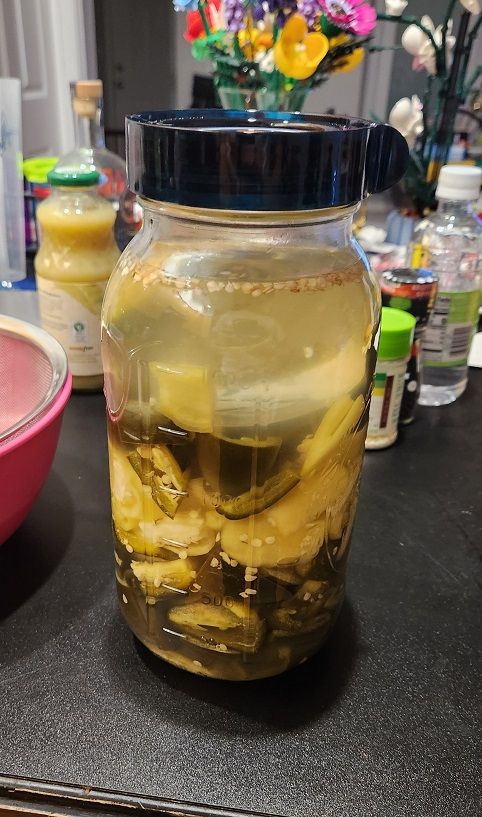
The Cook

After fermentation, peppers are filtered from the brine and both are retained. The peppers and 1/4 cup of brine were liquified in a blender until smooth and free of chunks. The ferment was pleasantly fragrant with a nutty/buttery scent. The amount of brine incorporated can be increased for a thinner sauce.
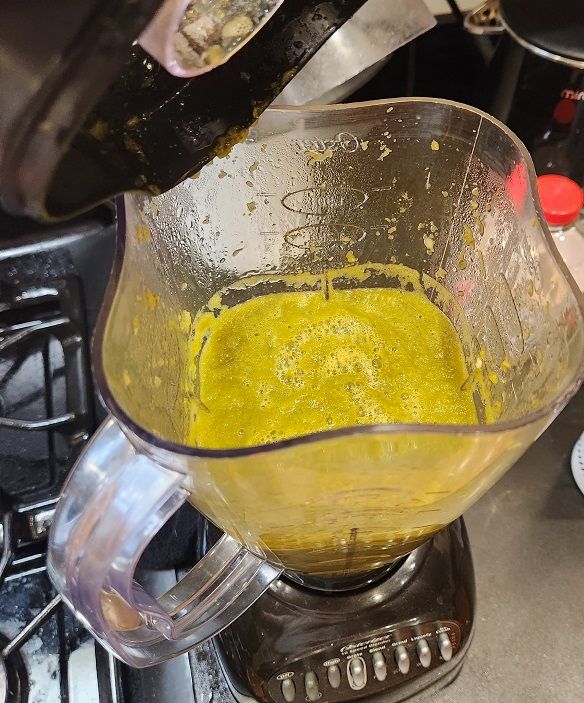
The liquified material was then brought to a boil in a lidded pot and held at a vigorous simmer for ~15 minutes. This kills any residual fermenting microorganisms so that the sauce does not continue to ferment. It also destroys any botulism toxin that may have formed during anaerobic fermentation (though this is generally considered unnecessary for fermented chili peppers). In addition, I find that cooking (as well as fermentation) results in a more rounded heat as opposed to the sharp heat from raw peppers.
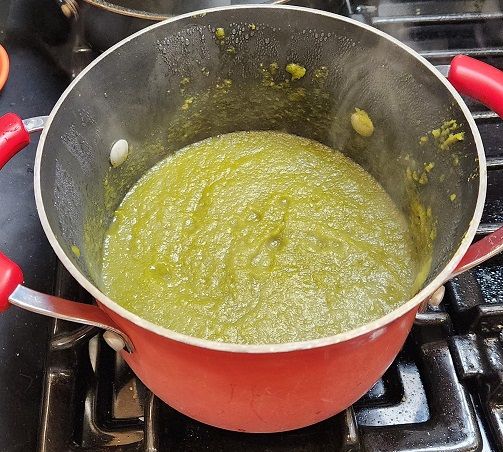
After cooking, the ferment was returned to the (cleaned) blender along with:
- 1/4 cup white vinegar (5% acid)
- 3/8 cup lime juice (not concentrate)
If more than 1/4 cup brine was used, increasing the amount of vinegar and lime juice proportionally is recommended.
The sauce was briefly blended until homogenous.
The Season-ing (?)
I often season fermented sauces pretty simply with just salt and a spice or two, but, since this sauce is milder than my typical variants, I decided to play more with seasoning. Some components (salt, onion powder, garlic, lime) were inspired by guacamole (which is green), some other components (agave syrup, also salt, also lime) were inspired by margaritas (also green-ish), and some were added because they just sounded good (like how Joe Greene did the football).
To the sauce was added:
- Regular Salt - 1/4 tsp
- Celery Salt - 1/2 tsp
- Garlic Salt - 1/2 tsp
- Smoked Paprika - 3/2 tsp
- Cracked Black Pepper - 1/4 tsp
- White Pepper - 1/2 tsp
- Onion Powder - 1/2 tsp
- Agave Syrup - 2 tbsp (simple syrup also works, but agave has tequila vibes)
It is highly recommended to taste incrementally during seasoning and adjust components (particularly salt and agave syrup) as needed.
At this point, the sauce was tasting quite good imho (very bright with a little bit of smoky notes and jalapeno spice). However, I think it was a little too un-mean. It's supposed to be mild, but it's also still supposed to be "hot sauce." To add a little kick, a single dried scorpion pepper was rehydrated in boiling water for 10 minutes and added to the sauce in the blender. I maintain that this is still within the theme(s) of this sauce since some fancy/gross bottles of mezcal and tequilla have a scorpion in them, for reasons. Everything was then given a brief final blendering. The pH of the final sauce was ~3.7. This is great since C. botulinum doesn't grow at a pH of below ~4.6, so any spores (which are not destroyed by boiling) should not become active and produce toxin. [But I'm not a real doctor (not even that great of a fake doctor if we are being honest), I'm just a guy making a reasonable effort not to poison anyone, so be safe out there]. I recommend refrigeration after transferring the sauce to sterilized bottles.
The Verdict

The Good
It tastes good. Like better than expected, quite enjoyably good. A random sampling of my coworkers also described it as "good" and "tasty" (though perhaps they were just being polite). It's a very slatherable sauce with quite a bit of zing/tang from the lime that is well balanced by the sugar, spices, and heat. Works great on burrito bowls or Thai food, but also tasty when liberally doused onto pizza or poured onto incredibly divisive meals that are "healthful" and "globally-inspired."
The Less Good
The consistency isn't great. It's a little too thicc, requires some effort to get out of the bottle, and plops somewhat unappealingly onto the surface of food without spreading out much. The amount of brine/vinegar/lime juice could be increased a bit.
The color is bad. It says "Greene" on the bottle, so you know it's probably supposed to be green. The color was more vibrant before the scorpion pepper was added (I'd use an under-ripened green one in the future, and maybe less paprika), and it also got worse over a few days as the sauce oxidized a bit. Then again, a lot of "green" hot sauces aren't that green, and it could be worse.
I'll definitely consider making this again.

